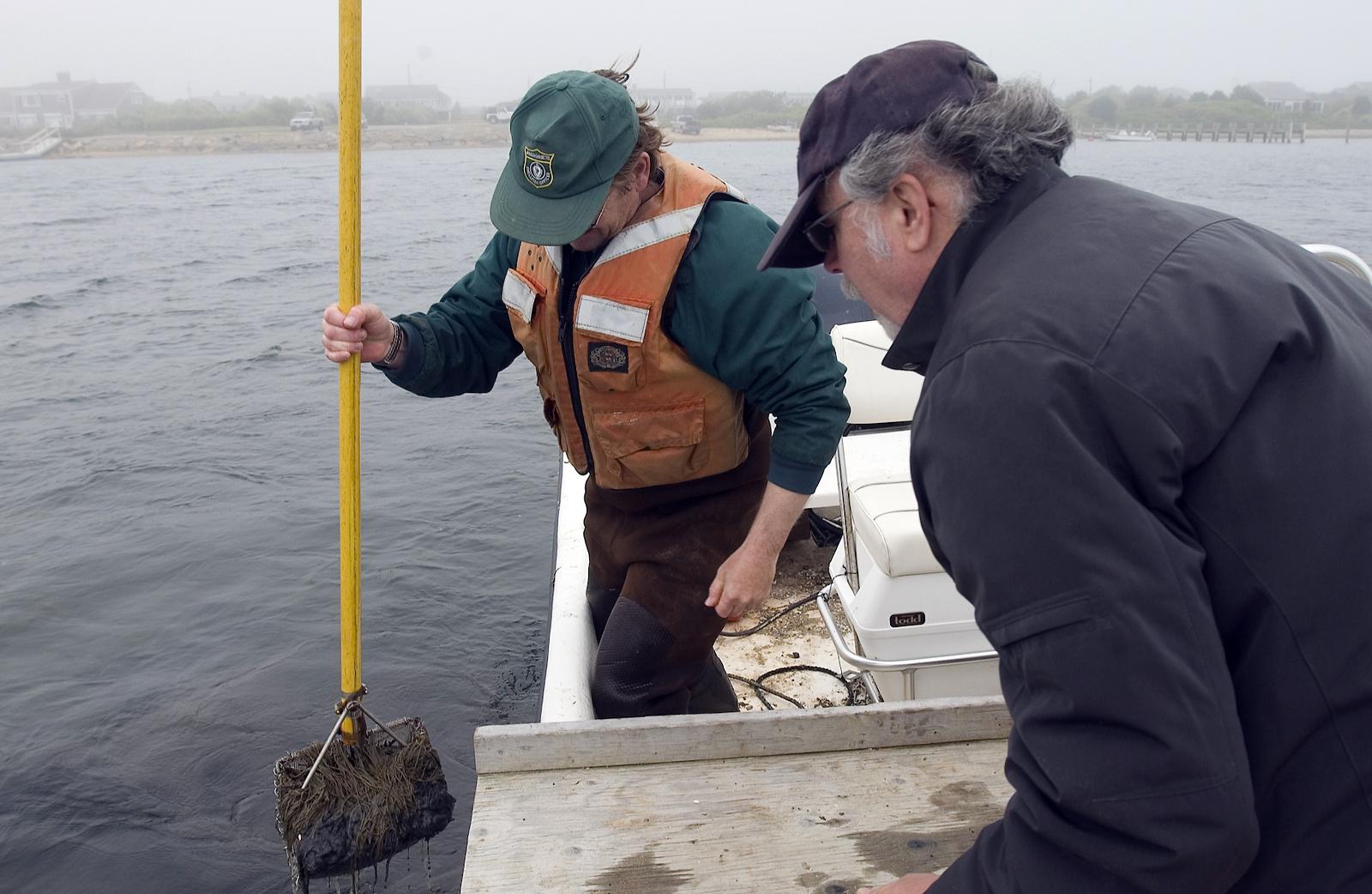The decline of eelgrass on the Vineyard and along the eastern seaboard has been known and documented for many years. Eelgrass is key to the health of a coastal pond ecosystem, and its disappearance has had a significant impact on sea life, fish and shellfish.
But in at least one area of Katama Bay, eelgrass appears to be coming back — thanks to the breach at Norton Point Beach, biologists believe. And the news could have ramifications for other ponds around the Island.
On Tuesday, Edgartown assistant shellfish constable Warren Gaines took Bill Wilcox, water resource planner for the Martha’s Vineyard Commission, out in a boat to investigate and document a new area of lush eelgrass first spotted a month ago.
The two men went out in a flat-bottomed powerboat, and they didn’t have to go far in the fog to find it. Several hundred yards from the Katama Bay public boat ramp, Mr. Gaines pointed to the spot only a few feet below the surface: acres of long-bladed eelgrass.
Mr. Gaines observed that throughout his 28-year career as a constable he has only seen eelgrass in decline. This is the first time he has seen it come back.
Mr. Wilcox pulled out a GPS device to precisely pinpoint the site for mapping. He then bent down and grabbed samples of the eelgrass for further inspection. Mr. Wilcox said he could see some evidence of wasting disease, but added that the strands of grass looked healthy and the plants seemed fully established.
Mr. Gaines observed that the strands of grass were indeed longer than he’d seen in a long time.
Since the Norton Point Beach breach took place two years ago in April, a significant new surge of seawater comes hourly into Katama Bay. Prior to the breach, the only exchange of seawater occurred through the harbor with the rising and falling tide. Now fresh seawater moves at a rapid clip from either direction.
What is so significant with the breach is the nearly continuous flow of cool seawater through the bay. “The amount of nitrogen in the water column, as a result of the opening, dropped by 25 per cent,” Mr. Wilcox said. “I suspect, I don’t have proof, but the reduction of nitrogen in the water is the root of the improvement in water quality and the return of eelgrass,” he added.
Eelgrass is a critically important element of any harbor or coastal pond. “When it is present, a pond can be vibrant, everything is right,” Mr. Wilcox said. “When eelgrass is gone, it indicates that something isn’t right.”
Among other things, eelgrass is critical to the life of growing bay scallops. The swimming larvae attach to the blades, before they eventually sink to the bottom. And many juvenile fish depend on eelgrass to provide safety from predators, including aggressive sea birds. “Blue claw crabs in the juvenile stage need eelgrass for cover from predators,” Mr. Wilcox said.
Eelgrass is in decline from Cape Cod down to the Chesapeake Bay.
“We started mapping eelgrass in Lake Tashmoo and Sengekontacket Pond way back in the late 1990s,” Mr. Wilcox said. Efforts included documenting the sites using divers with scuba gear.
There were experiments in finding ways to grow eelgrass beds, including transplanting and even planting seeds. “We dug up eelgrass off Eel Pond and planted it in Sengekontacket. We didn’t have much luck. One of the primary problems was crabs were feasting on the eelgrass,” Mr. Wilcox said. He continued:
“We tried seeding. It was much easier but it hasn’t worked in Sengekontacket yet.”
Mr. Gaines has vivid memories of Katama Bay full of eelgrass and a productive place for bay scallops and quahaugs. His memories go back to the 1970s, soon after the last breach had closed. “There were bay scallops and a quahaug fishery, a significant commercial quahaug fishery,” he said.
But water quality problems emerged, and they were not just linked to nitrogen coming from the land. Katama Bay was a popular anchorage for big boats; the town closed summer anchorage when it became widely known that some boats were dumping their holding tanks into the bay.
Now Mr. Gaines believes the Norton Point breach may be the best environmental event in the bay’s recent history. “Everything points to going back to what happened before,” he said. “It will become a healthy pond again.”
But it would be premature to say the pond has recovered.
Out on the bay, Mr. Wilcox and Mr. Gaines found a curious small animal residing on the bottom that looked foreign and a gray mat of growth that looked like a combination of seaweed and worms. Mr. Wilcox plans to investigate.
Mr. Gaines predicts the breach will last five to ten years, but be a smaller opening than it is now and be closer to Chappaquiddick, much like when he was growing up.
For Mr. Wilcox, the Tuesday morning boat trip pointed to new hope. “The way I see it, this is an indication of what kind of restoration can happen when the conditions are changed. In this case it was a natural change, there was a breach. The breach has allowed for greater tidal circulation,” he said, adding:
“It is also an indicator of what could happen if we change the conditions of a pond ourselves. The changes might be simply lowering the nitrogen that leaches into the ponds around the Island. It could mean steps to increase water circulation.”







Comments
Comment policy »